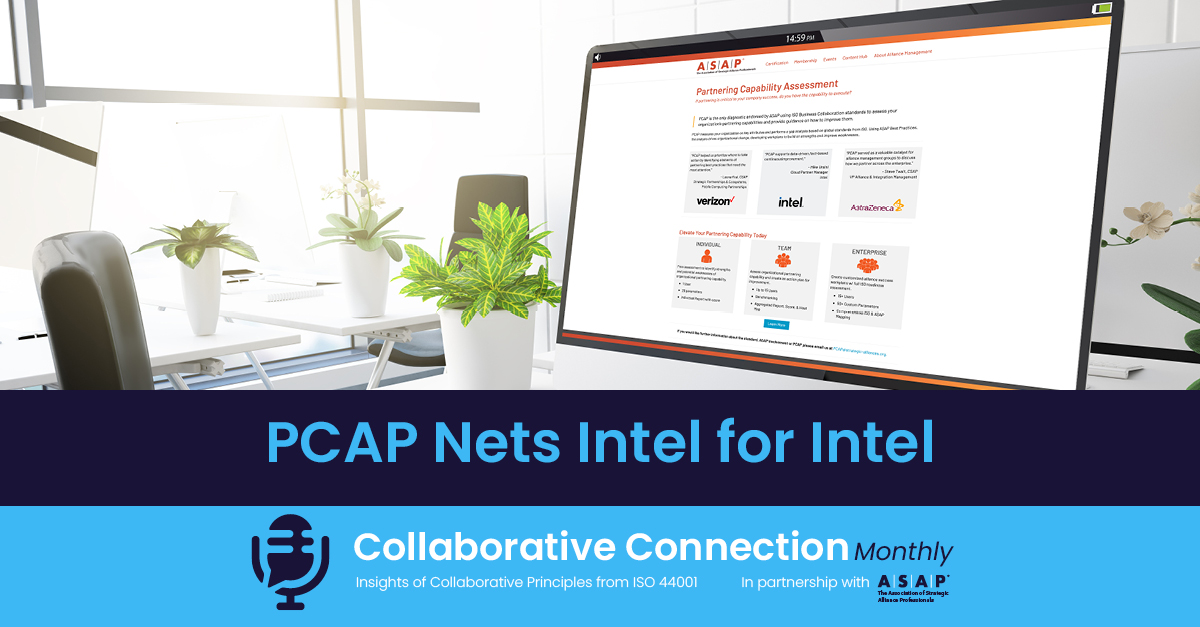PCAP Nets Intel for Intel
The Partnering Capability Assessment Platform (PCAP) is a diagnostic tool based on the ISO 44001 collaborative business standard. It is intended to measure the proficiency of an organization’s partnering capabilities against the global marketplace, diagnose areas of improvement, and provide a roadmap for shoring up those aspects of the alliance practice that could use a boost.
But how does the PCAP work? What does a successful implementation of the assessment look like in real life? Mike Ursini, cloud partner manager at Intel, walked attendees of the latest Collaborative Connection Monthly webinar and roundtable, “Benchmarking Your Partnering Capability for Competitive Advantage,” through his department’s recent use of the PCAP to improve its operation.
Harvesting Insights into Strengths and Weaknesses
Ursini, who is responsible for the global 100 tech industry institution’s high-performance computing (HPC) independent software vendor (ISV) relationships, mentioned that his department recently underwent significant change. Although Intel is no stranger to strategic alliances, Ursini’s team had doubled in headcount and picked up several new partners; stakeholders were now working with more people from diverse backgrounds. Ursini—who once led a sales call on a combine harvester—felt it was time for his group to reevaluate their collaboration processes against the outside world.
“It was important for us to do the PCAP because it helped us look at partnerships through a common lens, and we also adopted the common language so that we were all on the same page thinking and talking alike,” said Ursini.
Each individual on Ursini’s team took the PCAP, and the results came back with some good news. The team was very strong in three areas in particular: 1) accountability, 2) structure, and 3) sponsorship—it scored a 3.7 rating, which is “well, well above [IT’s] industry standard” of 3.0, according to Ursini. That didn’t mean there weren’t areas of improvement, though.
“We weren’t really considering risk assessment in partnerships. That was an area that we started thinking more about and including that in assessing who we partner with,” Ursini recalled.
Zeroing In on Three Priority Partners
The PCAP results also prompted this Intel division to jump on a growing trend in tech alliance management: it decided to put more energy into relatively few, highly strategic accounts. Where the team of 12 alliance professionals each once had close to 10 partners in their purview, individual alliance managers were now urged to focus on three top-priority allies.
“We were able to zero in on the accounts that we were going to be most successful with. The PCAP helped us make that transition from being spread a little thin to really getting much deeper into accounts,” said Ursini. “Of course, our targets and goals didn’t reduce, so we have to be very effective with the fewer accounts we have now.”
Get with the Program: Company over Tribe
Other changes included a more “programmatic” approach to partner selection that prioritized alignment to Intel’s main objectives over “tribal knowledge” based on team members’ past experiences with partner organizations.
“Are [partners] going to help us succeed and hit our goals, and [are] we [going to] bring value to them and help them hit their goals?” said Ursini, explaining the new recruitment criteria.
Data Drives Alliances Toward Continuous Improvement
Toward the end of the Q&A with Ursini, moderator Ann Trampas, CSAP, professional development practice lead at Phoenix Consulting Group and a senior lecturer at the University of Illinois–Chicago, noted that another benefit of the PCAP is that it is “fact-based,” which gives the results more credibility for the participating organization. Ursini emphatically agreed with this point.
“This is a great way to uplevel and provide the data to really know if you are being successful or what your gaps are. It’s more of a data-driven process, which I think helps give you the baseline of where you are at and where you need to get to,” he said.
For all of the great direction the PCAP provided, Ursini’s team still has some progress to make to reach its goal of gaining more of its partners’ attention by becoming a trusted advisor.
“We’re not at the strategic level yet, we’re at the systematic level, which is one level down. The goal is to be in that strategic area so that we can really help our partners be successful and grow their businesses,” Ursini said.
“Scoring at [the] systematic [level] is great, but there’s obviously [room for] continuous improvement,” added Trampas.
The next Collaborative Connection Monthly will take place April 13 when Sally Wang, group vice president of global strategic alliances and partnerships for International SOS, will dish on “Making It Better Together: Ecosystems and Coinnovation.”

